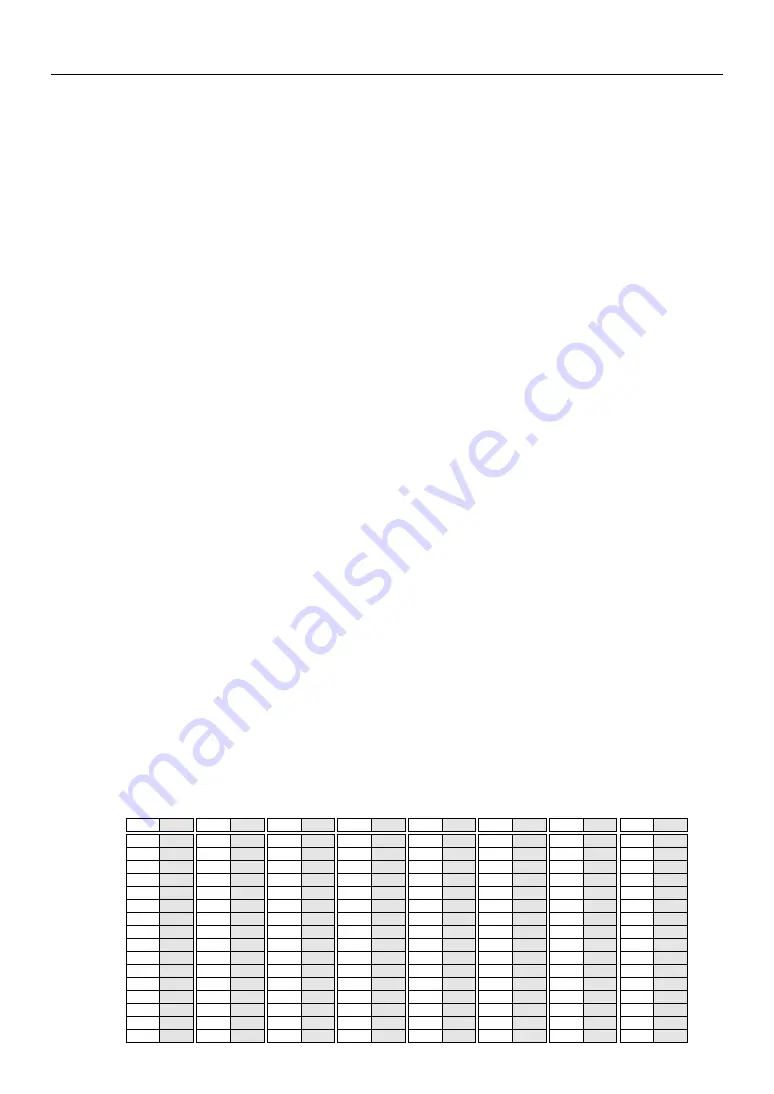
6
About MIDI
■
What is MIDI?
MIDI is an acronym that stands for Musical Instrument
Digital Interface, which allows electronic musical instru-
ments to “communicate” with each other, by sending and
■
Decimal - Hexadecimal Conversion Chart
10
11
12
13
14
15
16
17
18
19
1A
1B
1C
28
16
17
18
19
20
21
22
23
24
25
26
27
1D
29
Dec
Hex
Dec
Hex
Dec
Hex
Dec
Hex
Dec
Hex
Dec
Hex
Dec
Hex
Dec
Hex
1
2
3
4
5
6
7
8
9
10
11
12
13
00
01
02
03
04
05
06
07
08
09
0A
0B
0C
0D
32
33
34
35
36
37
38
39
40
41
30
31
1E
1F
20
21
22
23
24
25
26
27
28
29
2A
2B
42
43
48
49
50
51
52
53
54
55
56
57
58
64
65
66
67
68
69
70
71
72
73
80
81
82
83
84
85
86
87
88
96
97
98
99
100
101
102
103
112
113
114
115
116
117
118
0
14
0F
15
0E
2C
45
46
47
2D
2E
2F
30
31
32
33
34
35
36
37
38
39
3A
3B
60
61
62
63
3C
3D
3E
3F
40
41
42
43
44
45
46
47
48
49
4A
75
76
77
78
79
4B
4C
4D
4E
4F
50
51
52
53
54
55
56
57
58
59
90
91
92
93
94
95
5A
5B
5C
5D
5E
5F
60
61
62
63
64
65
66
67
68
105
106
107
108
109
110
111
69
6A
6B
6C
6D
6E
6F
70
71
72
73
74
75
76
77
120
121
122
123
124
126
125
78
79
7A
7B
7C
7D
7E
7F
127
44
59
74
89
104
119
Many MIDI messages listed in the MIDI Data Format section, beginning on page 7, are expressed in hexadeci-
mal numbers. The chart below lists the corresponding decimal number for each hexadecimal number. (Hexa-
decimal numbers may include the letter “H” as a suffix.)
receiving compatible Note, Control Change, Program
Change and various other types of MIDI data, or messages.
■
MIDI Messages Received by the DB50XG
The DB50XG is controlled by various types of incoming
MIDI messages which automatically determine play mode,
select MIDI channels, Voices and effects, change param-
eter values, and of course play the Voices specified for the
various Parts—complete with all the subtle nuances and
powerful dynamics of expression that the composer origi-
nally intended. Below is an explanation of the various types
of MIDI messages which the DB50XG can receive.
●
Key On/Key Off
Key On/Key Off messages, also called Note messages, tell
the DB50XG which notes to play, the Velocity value (de-
pending on how hard the keys are struck) at which to play
them, and how long to play them—i.e., when to start (On)
and stop (Off) playing each note.
●
Control Change
Control Change messages let you select a Voice bank, con-
trol volume, panning, modulation, portamento time, bright-
ness and various other controller parameters, through spe-
cific Control Change numbers which correspond to each
of the various parameters.
●
Program Change
Program Change messages tell the DB50XG which Voice
to select for each Part. You can insert Program Change
messages at any desired location in a song. Combining Bank
Select numbers let you select various Voices from the hun-
dreds of Voices available in the DB50XG.
●
Pitch Bend
Pitch Bend messages are continuous controller messages
that allow the pitch of designated notes to be raised or low-
ered by a specified amount over a specified duration.
●
Channel Aftertouch
Channel Aftertouch is a pressure sensing function which
lets you control various functions by how hard you press
the keys, over the entire channel.
●
Polyphonic Aftertouch
Polyphonic Aftertouch is a pressure sensing function which
lets you control various functions by how hard you press
the keys, for each individual key.
●
System Exclusive
System Exclusive messages control various functions of
the DB50XG, including master volume and master tuning,
play mode (XG or TG300B), effect type and various other
parameters specifically related to the DB50XG.
Содержание DB50XG
Страница 1: ...2 GENERAL Owner s Manual Mode d emploi ...
Страница 14: ...13 Mode d emploi ...








































